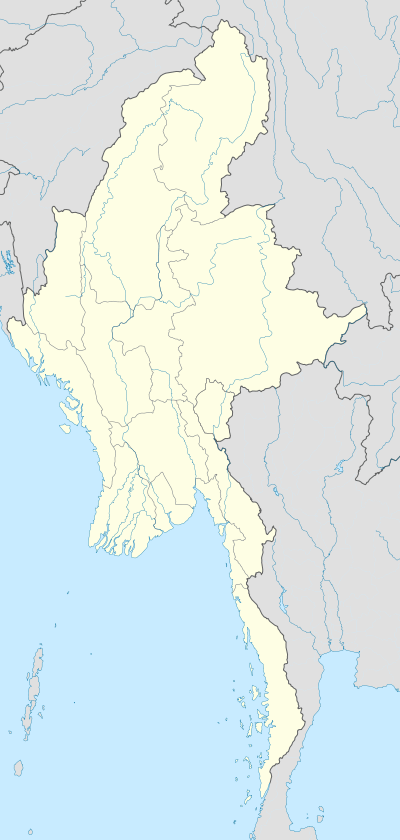Pyinmana
Pyinmana (Burmese: ပျဉ်းမနားမြို့; MLCTS: pyanymana: mrui., IPA: [pjɪ̀ɰ̃məná mjo̰]; population: 100,000 (2006 estimate)) is a logging town and sugarcane refinery center in the Naypyidaw Union Territory of Myanmar. The administrative capital of Myanmar was officially moved to a militarized greenfield site (which the leader, Than Shwe, dubbed Naypyidaw, or Royal City) two miles (3.2 km) west of Pyinmana on November 6, 2005. Pyinmana is approximately 200 miles (320 km) north of Yangon. The village of Yezin, a few miles north and east of Pyinmana, has been the site of national scientific research institutions since the late 1970s.
Pyinmana ပျဉ်းမနားမြို့ | |
|---|---|
Town | |
 Pyinmana Location of Pyinmana, Myanmar (Burma) | |
| Coordinates: 19°45′N 96°12′E | |
| Country | |
| Division | Naypyidaw Union Territory |
| Population (2006 est.) | |
| • Total | 100,000 |
| • Ethnicities | Bamar, Burmese Indians, Kayin |
| • Religions | Theravada Buddhism, Islam |
| Time zone | UTC+6.30 (MST) |
During World War II, Pyinmana was the base of the Burma Independence Army (later renamed and reorganized into the Burma Defence Army by the Japanese).[1] It was in Pyinmana that the army and its officers were trained. Later the Burma National Army changed sides, aiding the Allies with guerrilla warfare, and the operations were seen as a victory by the Burmese. Pyinmana became an icon in the Burmese Army where it was seen as the place where 'superior invaders' were defeated by the Burmese. This may be one of the reasons why the current junta chose to locate the newly built capital Naypyidaw in such close proximity to Pyinmana.
Climate
| Climate data for Pyinmana (1981–2010) | |||||||||||||
|---|---|---|---|---|---|---|---|---|---|---|---|---|---|
| Month | Jan | Feb | Mar | Apr | May | Jun | Jul | Aug | Sep | Oct | Nov | Dec | Year |
| Average high °C (°F) | 31.5 (88.7) |
34.4 (93.9) |
37.2 (99.0) |
38.7 (101.7) |
36.0 (96.8) |
32.4 (90.3) |
31.4 (88.5) |
31.3 (88.3) |
32.5 (90.5) |
33.2 (91.8) |
31.8 (89.2) |
30.5 (86.9) |
33.4 (92.1) |
| Average low °C (°F) | 14.6 (58.3) |
16.4 (61.5) |
20.4 (68.7) |
24.3 (75.7) |
24.9 (76.8) |
24.3 (75.7) |
24.0 (75.2) |
23.9 (75.0) |
23.9 (75.0) |
23.3 (73.9) |
20.2 (68.4) |
16.0 (60.8) |
21.3 (70.3) |
| Average rainfall mm (inches) | 2.2 (0.09) |
5.0 (0.20) |
3.9 (0.15) |
36.3 (1.43) |
156.5 (6.16) |
209.1 (8.23) |
227.7 (8.96) |
263.0 (10.35) |
177.0 (6.97) |
167.0 (6.57) |
50.4 (1.98) |
4.8 (0.19) |
1,302.9 (51.30) |
| Source: Norwegian Meteorological Institute[2] | |||||||||||||
Notable residents
- Bo Let Ya Bo Htauk Htain Bo Tar Yar
See also
References
- McGirk, Jan (November 8, 2005). Burma's rulers take the road to Mandalay. The Independent.
- "Myanmar Climate Report" (PDF). Norwegian Meteorological Institute. pp. 23–36. Archived from the original (PDF) on 8 October 2018. Retrieved 28 October 2018.